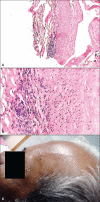Giant cell arteritis (temporal arteritis): A report of four cases from north east India
- PMID: 19893667
- PMCID: PMC2771971
- DOI: 10.4103/0972-2327.42940
Giant cell arteritis (temporal arteritis): A report of four cases from north east India
Abstract
Giant cell arteritis (GCA) is a common disease of the geriatric age group in the western world, with a prevalence of 0.2% in the fifty plus age group. It is an important cause of morbidity, with irreversible visual loss being the most ominous complication. This diagnosis is an important consideration in all cases of new onset headache in elderly subjects. Reports of giant cell arteritis are few and far between in the Indian subcontinent. In this report, we describe the clinical details of four cases of giant cell arteritis, detected at Guwahati, Assam. The four patients were in the 70-82 age group. Sex distribution was equal. All of them had polymyalgia rheumatica (PMR), with one case displaying an initial presentation as only PMR. Cardinal manifestation was a severe headache, frequently accompanied by scalp allodynia and abnormalities of the superficial temporal artery (STA) on examination. STA biopsy yielded histopathological confirmation in three patients. Permanent visual loss was noted in one patient. These cases highlight the importance of assessing the possibility of giant cell arteritis through appropriate clinical history, estimation of acute phase reactants and the judicious use of superficial temporal artery biopsy, to clinch the diagnosis.
Keywords: Giant cell arteritis; polymyalgia rheumatica.
Conflict of interest statement
Figures

References
-
- Horton BT, Magath TB, Brown GE. An undescribed form of arteritis of the temporal vessels. Mayo Clin Proc. 1932;7:700–1.
-
- Lawrence RC, Helmick CG, Arnett FC, Deyo RA, Felson DT, Giannini EH, et al. Estimates of the prevalence of arthritis and selected musculoskeletal disorders in the United States. Arthritis Rheum. 1998;41:778–99. - PubMed
-
- Hunder GG, Bloch DA, Michel BA, Stevens MB, Arend WP, Calabrese LH, et al. The American College of Rheumatology 1990 criteria for the classification of giant cell arteritis. Arthritis Rheum. 1990;33:1122–8. - PubMed
-
- Mahkrishnan K. Temporal arteritis following trimethoxy psoralen therapy. Indian J Dermatol Venereol Leprol. 1981;47:53–5. - PubMed
-
- Yadav S, Bambery P, Wanchu A, Kakkar N, Singh S. Giant cell arteritis as a cause of jaw claudication. Neurol India. 2004;52:397–8. - PubMed

